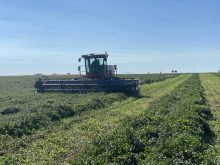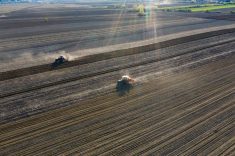Misplaced the operator manual to your tried-and-true old tractor? Wondering how to safely tow an older implement with your new high-speed tractor? You’ll find the answers to these and other farm equipment hitching questions in a new guidebook, Safe Implement Hitching.
Jim Wassermann, an engineer with the Prairie Agricultural Machinery Institute (PAMI) in Saskatchewan, is a member of the team of farmers, engineers and machinery experts that produced the guidebook. He says, “Over the years, PAMI received so many questions from farmers who wanted to hitch up their older equipment safely that we decided to put all the answers into a new guide.”
Read Also

How a southern Alberta farm maintains mint condition
An estimated 25 per cent of North America’s mint oil is now the product of a southeastern Alberta farming business, but don’t get the idea that commercial mint production is a job for the faint of heart.
Wassermann encourages farmers to obtain a copy to use as a supplement for their tractor and implement operator manuals. The 42-page guidebook is farmer-friendly and features color photos, illustrations and tables of data.
Featured hitching connections are: drawbars, three-point hitches, power-take-offs (PTOs), hydraulic and electrical. And there’s a safe way to do them all based on knowledge of the equipment being connected, an understanding of the procedures required for a safe tractor-to-implement connection, operator skill and respect for personal and public safety. The guidebook provides a checklist of all these safety concerns.
In general, before hitching a tractor to any implement, check the safe hitching guide’s hazard assessment and safety plan. You’ll find a list of questions. Answer them and you will be able to identify, estimate and evaluate risks and develop a safety plan.
Here are a couple of the questions: Does the operator have sufficient knowledge and skill? What are the potential risks to the operator, bystander, public, equipment, property? What severity is associated with the risks? Slot the answers into a safety plan and you’re ready to get hitched!
The information in the guidebook is all practical and useful. Not surprising because it’s based on information from farmers and engineers as well as the Canadian Standards Association (www.csa.ca), the American Society of Agricultural and Biological Engineers (www.asabe.org), the American National Standards Institute (www.ansi.org), Occupational Safety and Health Association (www.osha.gov), and the International Organization for Standardization (www.iso.org).
Safe Implement Hitching is available as a free, downloadable PDF. Go to www.planfarmsafety.ca and type ‘hitch’ in the search box. Safe Implement Hitching was produced with financial support from the Canadian Agricultural Safety Association (CASA) and the Association of Equipment Manufacturers (AEM). †














